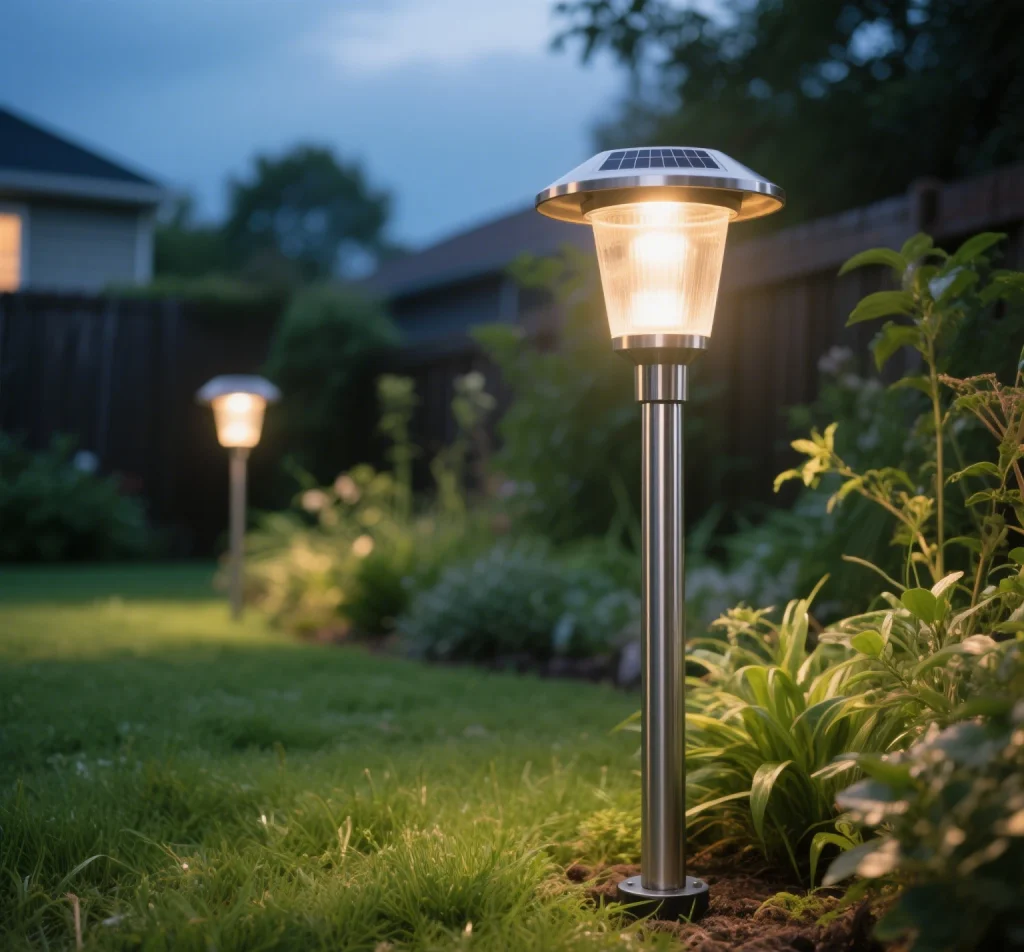Solar lamps are revolutionizing outdoor lighting with their promise of sustainability. But how much do they actually reduce carbon emissions? This article uses data to quantify the environmental impact of solar lighting, examines its lifecycle footprint, and offers practical tips to maximize its green benefits, helping you make informed choices for a cleaner planet.

How Solar Lighting Cuts Carbon Emissions
A solar lamp typically includes a photovoltaic (PV) panel, a battery, an LED light, and a charge controller. Unlike traditional grid-powered lights, which often rely on fossil fuels, solar lamps harness sunlight, producing zero emissions during operation. To illustrate, consider a 10W solar lamp replacing a 60W incandescent bulb used for 5 hours daily.
With a global average grid emission factor of 0.5 kg of CO2 per kWh, the incandescent bulb consumes 0.3 kWh daily (60W × 5h), emitting 0.15 kg of CO2 per day or 54.75 kg annually. A solar lamp eliminates this entirely, saving approximately 55 kg of CO2 emissions per year—roughly equivalent to the carbon absorbed by one mature tree. This makes solar lamps a powerful tool for reducing your carbon footprint.
Lifecycle Carbon Footprint of Solar Lamps
While solar lamps have no operational emissions, their production, transportation, and disposal generate a carbon footprint. Manufacturing silicon-based PV panels, lithium batteries, and aluminum or plastic housings is energy-intensive. Estimates suggest a 5-10W solar lamp has a lifecycle carbon footprint of 10-20 kg of CO2, depending on production practices and supply chain logistics.
However, these upfront emissions are quickly offset. A solar lamp with a 3-year lifespan saves 165 kg of CO2 (55 kg/year × 3) when replacing an incandescent bulb, far surpassing its production footprint. To enhance sustainability, opt for brands with eco-friendly certifications, such as those listed on Energy Star, or those offering battery recycling programs.
Solar Lamps vs. Other Lighting Technologies
To fully appreciate the green value of solar lighting, let’s compare it to other outdoor lighting options:
- Incandescent Bulbs: A 60W bulb emits 55 kg of CO2 annually, as calculated earlier, due to its high energy consumption.
- CFLs (Compact Fluorescent Lamps): A 15W CFL, equivalent to a 60W incandescent, consumes 0.075 kWh daily, emitting 13.7 kg of CO2 yearly—still higher than a solar lamp’s zero.
- Grid-Powered LEDs: A 10W LED uses 0.05 kWh daily, emitting 9.1 kg of CO2 annually. While efficient, it relies on the grid, unlike solar lamps.
- Kerosene Lamps: Common in off-grid regions, kerosene lamps emit 0.1-0.2 kg of CO2 per hour, plus pollutants like black carbon. A solar lamp eliminates these entirely.
Solar lamps excel in high-emission grid areas or off-grid settings, delivering the greatest carbon reduction where fossil fuels dominate.
Key Factors Affecting Carbon Savings
Several factors influence how much CO2 a solar lamp can save:
- Grid Carbon Intensity: In coal-heavy grids (e.g., 0.8 kg CO2/kWh), savings are higher than in renewable-heavy grids (e.g., 0.2 kg CO2/kWh).
- Usage Duration: A lamp used 8 hours daily saves 87.6 kg of CO2 annually, compared to 55 kg at 5 hours.
- Lamp Efficiency: Higher lumens per watt (e.g., 100 lumens/W vs. 80 lumens/W) maximizes energy efficiency, reducing the need for larger panels.
- Battery Durability: Batteries like LiFePO4 (2000 cycles) outlast lithium-ion (500 cycles), reducing replacement frequency and lifecycle emissions.
By optimizing these factors, you can significantly boost your lamp’s environmental impact.
Innovations Enhancing Sustainability
Advancements in solar lamp technology are amplifying their green benefits. Bifacial solar panels, which capture sunlight on both sides, increase energy yield by 5-20%, reducing the need for larger panels and lowering production emissions. MPPT charge controllers (Maximum Power Point Tracking) optimize energy harvest in varying light conditions, improving efficiency by 10-30% over PWM controllers.
Smart features like motion sensors conserve energy by activating lights only when needed, extending battery life and maximizing carbon reduction. Some lamps use recycled materials, such as reclaimed aluminum or plastic, further reducing their environmental footprint. Brands like BioLite and Goal Zero are pioneering these sustainable innovations.
Applications of Solar Lamps
Solar lamps serve diverse outdoor needs, each with unique carbon-saving potential:
- Garden Lighting: Low-lumen lamps (100-300 lumens) save 10-20 kg of CO2 annually while enhancing ambiance.
- Security Lighting: High-lumen lamps (1000+ lumens) with motion sensors save 50-80 kg of CO2 yearly while deterring intruders.
- Off-Grid Communities: Replacing kerosene lamps in remote areas cuts emissions and eliminates harmful fumes, improving health.
- Emergency Lighting: Solar lamps with USB charging provide backup power, reducing reliance on diesel generators.
Choosing the right lamp for your application ensures both functionality and sustainability.

Tips to Maximize Carbon Savings
To get the most out of your solar lamp’s carbon reduction potential, consider these strategies:
- Select Durable Lamps: Choose models with robust materials (e.g., tempered glass, aluminum) and high IP ratings (e.g., IP65) for longevity.
- Optimize Panel Placement: Position the PV panel in direct sunlight, avoiding shade, to maximize energy capture.
- Maintain Regularly: Clean panels to remove dust or debris, which can reduce efficiency by 5-10%.
- Recycle Responsibly: Use certified recycling programs, like those on Call2Recycle, to dispose of batteries safely.
- Leverage Smart Features: Use motion sensors or dimming modes to minimize energy use and extend battery life.
Challenges to Consider
Solar lamps aren’t without limitations. Their upfront carbon emissions from production (10-20 kg CO2) take 1-2 years to offset, depending on usage. In cloudy regions, energy output may drop, requiring larger panels or hybrid charging options. Improper battery disposal can also harm the environment, underscoring the need for responsible recycling.
Cost is another factor. Premium lamps with features like MPPT charge controllers or bifacial panels are more expensive, though their durability and efficiency justify the investment. Budget models may have shorter lifespans, increasing replacement frequency and environmental impact.
The Wider Impact of Solar Lighting
On a larger scale, solar lamps contribute to global sustainability goals. Replacing kerosene lamps in off-grid regions could cut millions of tons of CO2 annually, per World Bank estimates. In urban areas, solar lamps in public spaces like parks or streets reduce municipal energy costs and support climate targets.
Solar lamps also promote energy equity. Organizations like SolarAid note that a single lamp can save a family $70 annually in kerosene costs while cutting 0.2 tons of CO2. This dual benefit of affordability and environmental impact makes solar lamps a game-changer for underserved communities.
Conclusion
A single solar lamp can save 55-100 kg of carbon emissions annually, depending on usage and grid conditions, offering a simple yet effective way to green your outdoor lighting. By leveraging innovations like bifacial panels and motion sensors, and following best practices for placement and maintenance, you can maximize these savings. Explore reviews on CNET or Wirecutter to find reliable models. With the right solar lamp, you can illuminate your space while making a tangible contribution to a sustainable future.


Leave a Reply